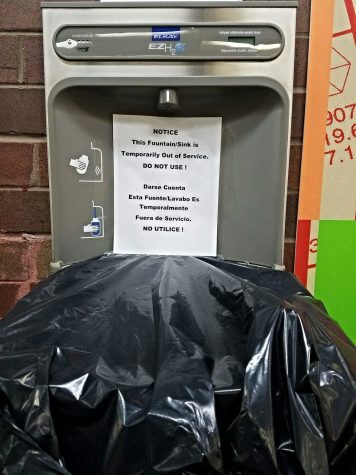What’s in the water for Whitney Young? Lead Poisoning?
Lead in the school’s water? what does this mean for students?
November 9, 2016
We’ve all seen the signs on our sinks and drinking fountains “DO NOT USE.” But the paragraph explanation as to why our water isn’t potable put into the Whitney Young newsletter didn’t seem to be enough to qualm students’ uneasiness about the safety of our drinking water, so what really happened? The official statement from CPS explains that “In light of national events that have brought increased attention to the issue of water quality, the City of Chicago announced several additional precautionary measures that will be added to the City’s water testing protocol, continuing the City’s track record of complying with current state and federal regulations as well as exceeding industry standards.”
Dr. Kenner and the school’s engineer Mr. Karevia both declined to give an official statement on the matter. The information parents and students received in the newsletter was originally provided to our school from Dan Moore of CPS Project control explained that five of our school’s sinks and drinking fountains have water samples above the US environmental protection agency’s action lead level of 15 ppb (parts per billion). Our school was built 41 years ago and odds are that it has had the same piping ever since; although information on any repairs or upgrades that may have been made since are unavailable and because of this there is no way of determining how long the levels have been unsafe. Older piping is more likely to contain lead or other contaminants, which are what may have been the source of the problems.
The affected facilities received results of 15, 17, 22 and 24 ppb in drinking fountains in addition to sinks in storage rooms (which students do not have access to) that tested at shocking numbers of 16, 26, 74, and 170 ppb of lead. The full list of results is available online at http://cps.edu/Pages/LeadTesting.aspx
So why test now? The aforementioned national events that caused this testing to be done is the Flint Michigan water crisis (April 2014 – present). Already dozens of schools in addition ours have had unsafe levels of lead and many more schools are still to be tested. But the biggest question remains: are we at risk for lead poisoning?
In short: No.
Even though the effects of lead poisoning are nasty with symptoms including: irritability, fatigue, loss of appetite, vomiting, abdominal pain, joint and muscle pain, declines in mental function and headaches. There’s no need to fret because many of these are also caused by different factors, for example, simply being a stressed student in a magnet high school. In order to develop symptoms it requires doses larger than 15 ppb over a long period of time. Lead poisoning also primarily affects children ages six and younger so we, as high school aged students, have little to be concerned about. However, if you are still concerned you may have been effected talk to your doctor or pediatrician about having a lead screening to determine whether or not you may have been affected.
Mia Bonds
Nadia Strong
Katie Eppley
